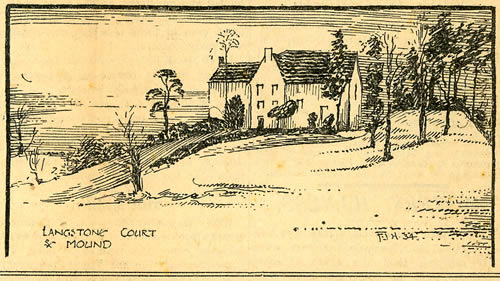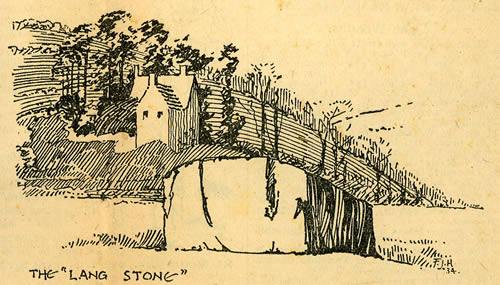Much is known about the Roman remains in Caerleon, but we know surprisingly little about the Norman Castle that was constructed outside the fortress walls some 800 years after the Second Augustan Legion left.
Only the castle mound, the foundations of a tower at its base and one tower, adjacent to the Hanbury Arms, can still be seen. Where the rest of the castle was no-one knows for sure!
The mound (or Mynde as it is sometimes known) is not without its mysteries... In 1878 the landowner, drove a tunnel into it to find out something of its history. Was it pre-Roman, Roman or Norman? What he found suggested it was Norman as it seemed to cover Roman remains. The jury is still out though... maybe a job for Time Team...
This months picture comes from the South Wales Argus, Monday June 25th 1934. Local historian Fred Hando explores evidence that the Mynde is pre-Roman:
OLD TRACKS OF GWENT - 4
EVIDENCE THAT THE MYNDE IS PRE-ROMAN
- o-
A "Lang Stone" Which Would Not Be Removed
- o -
By MR. F. J. HANDO.

In the endeavour to interest readers of the Argus in their own countryside, I am obliged, when "ley-spotting," to cover ground already familiar to them. Frequently, however, although we may have "passed them a hundred times," we discover things that we had not noticed before.
Is there about the ancient city of Caerleon a single object of note that can yield a particle of information not previously wrung from it? Excavators, archaeologists, poets, have contributed to our knowledge; let us apply the lore of the ancient straight track to one of its mysteries.
Attention has been given of late to the great tump known as the Mynde. Three hundred yards in circumference at the base, it stands "without the city walls," noble in design, beautifully crowned with trees. Giraldus Cambrensis and Churchyard were impressed by it in their days. Historians throughout the ages have wrangled over it. Roman remains have been found within it; it has been variously ascribed to British, Roman, Saxon, and Norman builders. Yet I believe that there is something to be said for an origin earlier than any of these.
Most authorities agree that there was a hill fort above Caerleon in the marvellous entrenchment known now as Lodge Camp. The hill cities preceded the cities of the plain, as the ridge ways preceded the valley tracks. Now the way from Lodge Camp to Caerleon descends the fields in a straight line, and the observer will see that this track, if continued, would lead to the Mynde. (Beyond the Lodge Camp, by the way, this same track is continued as a wide green road through fields). This in itself, is of course, little evidence.
Add to this fact the following, which can be checked easily on the six-inch Ordnance Survey Map:
The "Mynde" is in a perfectly straight line with Mount St. Alban's, Pentoppen Ash Camp, and Castell Prin Camp.
These two observed facts may be mere coincidences, but I am satisfied that the Mynde dates back to pre-Roman days, and I ask all those interested to explore the territory indicated by these names.
Leaving Caerleon-ultra-Pontem by the Bulmoor-road we come soon to Great Bulmoor. The chapel-like structure on the left - with its ancient cider-mill and stone staircase - marks the spot with interest. Roman remains and tombs have been discovered here, but it is of more immediate concern to know that a track passes straight up the steep hill to the right to the spot, where tradition says, St. Alban, the Martyr of Caerleon, lies buried.
Standing on this windswept hillside a short time ago, I discovered clearly, over the shoulder of an intervening hill, the tree-clad mound at Caerleon, and beyond it, the place sacred to the memory of Alban's fellow martyr, the saintly Julian. These three points align.
The track continues past the house, and joins the Christchurch-road at an interesting little pool containing an island on which grows a tree. The camp at Pentoppen Ash, and its aligned camp at Castell Prin, are then easily reached, and command grand views in every direction. ("Pentoppen," you should note, is the name used on old maps to denote the height on which the barracks at Newport stand, and the Ash tree, taken in conjunction with Cat's Ash, Croes-Onen, and Nash, is of importance.)
RETURNING to the little pool at St. Alban's, we notice a stone stile opposite, which suggests a continuation of the Bulmoor-St. Alban's track. For our purposes, however, take the next gate, towards Wentwood, on the right, and you will find yourselves on another of those ancient green roads. At the barn, another wide road plunges into the valley, and the farmers know this as the "Camp Road." If this road is very muddy, a field track is available, but whichever course you take, you will find at the top of the opposite hill the earthworks of an ancient camp known now as Priory Wood Camp.
Priory Wood Camp is on ground owned until recent years by Eton College. It is four-sided, but not rectangular. My sketch-plan will make this clear. No Roman engineer would have been "found dead in it," for the right angle was as sacred to the Roman as his beloved semi-circle.
Stand at the western corner of the camp and take a sight south-eastward along the earth bank. You will be delighted, as I was, to see the tree-crowned tump at Langstone in perfect alignment. The opposite earthwork is continued as a track beyond the Christchurch-road, and leads to Little Bulmoor. The south-east earthwork aligns on Pentoppen Ash Camp. In other words, this was a wayside camp at the junction of three ancient tracks.
A delightful path from the Camp threads Priory Wood and leads to Langstone. Climbing the hill, we reach the grounds in which stands yet another memorial of the " silent vanished races." In. 1860 the roadmakers deepened the old hollow way by cutting into the moat surrounding the tump, and in the process came across some human remains. Langstone Tump may have been a burial mound; that it was a sighting point on a track will be immediately evident if you will take your O.S. map and stretch a piece of cotton from the position of the tump to the position of Redwick Church. The old track is clear as it leaves the coast, clear again between Redwick Church and Greenmoor, then aligning on Bishton Church, Langstone Tump and so to the camp at Priory Wood.

The name "Langstone" is Saxon, in a Welsh district. Into this mystery we shall not delve, but where, you ask, is this lang stone? A path leaves Langstone Court eastwards, and disappears in the field. Continue in the same direction, and you will see, ahead of you, what is apparently a line of bushes, but is actually a remnant - a marvellous remnant - of a prehistoric track, deep in the heart of a modern field. Canopied by bushes, wide, deep, mysterious, it continues the length of a football field, and then disappears, but if you persist in its direction, you will find, in a field topping the next ridge ("stony-field") a great stone, shaped in plan roughly like a bishop's mitre.

A few years ago it was decided to aid the ploughman by removing this stone. A farmhand who was present on that occasion tells me that every available horse and man was pressed into service. A chain was fastened to the stone. Horses and men engaged in a great "heave," yet the old landmark won! To what depth is it sunk? Sufficient, you will agree, to justify my contention that this is the "Lang Stone."
See our web pages about the Mynde: click here
|